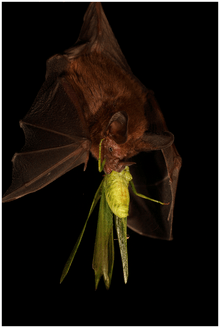Common big-eared bat
The common big-eared bat (Micronycteris microtis) is a bat species from South and Central America. It is a neotropical leaf-nosed bat (a member of the family Phyllostomidae).
| Common big-eared bat | |
|---|---|
 | |
| Scientific classification | |
| Kingdom: | Animalia |
| Phylum: | Chordata |
| Class: | Mammalia |
| Order: | Chiroptera |
| Family: | Phyllostomidae |
| Genus: | Micronycteris |
| Species: | M. microtis |
| Binomial name | |
| Micronycteris microtis Miller, 1898 | |
 | |
Recent research has demonstrated this bat's ability to find motionless food within clutter.[2] Echolocating bats discriminate between background and prey based on glints or Doppler shifts in the echo induced by the (wing-)movements of the prey, but M. microtis can detect completely motionless prey. The species shares both the leaf-nose formation and the trait of sound emission through the nostrils with all Phyllostomidae, but its behavior is understood to be unique: the bat is able to discriminate ecologically relevant stimuli within an extremely complex cluttered sonic environment.
The echolocation call of M. microtis is a broad band multi-harmonic FM sweep with most energy in the second harmonic between 95 and 75 kHz, i.e. quite similar to that of Macrophyllum macrophyllum, although presumably of lower intensity.
M. microtis mothers will provide pups with prey items for 5 months after weaning.[3]
Description
It is a small species of bat with individuals weighing 3.4–9.1 g (0.12–0.32 oz). Its forearm length is 32–38 mm (1.3–1.5 in). Its ears are large and rounded, at 18–23 mm (0.71–0.91 in) long. Its ears are connected by an inter-auricular membrane. Its fur is brown, with geographic variation in the shade of brown. Its dental formula is 2.1.2.32.1.3.3 for a total of 34 teeth.[4]
Range and habitat
It is found in several countries in Central and South America. Its range includes: Belize, Bolivia, Brazil, Colombia, Costa Rica, El Salvador, French Guiana, Guatemala, Guyana, Honduras, Mexico, Nicaragua, Panama, and Venezuela[1]
References
- Solari, S.; Camacho, M. (2019). "Micronycteris microtis". IUCN Red List of Threatened Species. 2019: e.T136424A21985267. doi:10.2305/IUCN.UK.2019-2.RLTS.T136424A21985267.en.
- Geipel, Inga; Jung, Kirsten; Kalko, Elisabeth K. V. (2013-03-07). "Perception of silent and motionless prey on vegetation by echolocation in the gleaning bat Micronycteris microtis". Proc. R. Soc. B. 280 (1754): 20122830. doi:10.1098/rspb.2012.2830. ISSN 0962-8452. PMC 3574334. PMID 23325775.
- Geipel, Inga; Kalko, Elisabeth K. V.; Wallmeyer, Katja; Knörnschild, Mirjam (2013-06-01). "Postweaning maternal food provisioning in a bat with a complex hunting strategy". Animal Behaviour. 85 (6): 1435–1441. doi:10.1016/j.anbehav.2013.03.040.
- Tellez-Giron, G.; Ceballos, G. (2014). Ceballos, G. (ed.). Mammals of Mexico. JHU Press. pp. 683–684. ISBN 978-1421408439.
